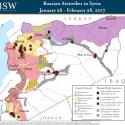 |
 |
Russian Airstrikes in Syria: January 26 – February 28, 2017
Mar 3, 2017 - ISW Press

By Jonathan Mautner

Russia waged an aggressive air campaign against critical civilian infrastructure in southern and northern Syria from February 12 – 27, marking the continuation of a policy Russia has implemented since the start of its intervention in the Syrian Civil War. Russia conducted heavy waves of airstrikes against opposition terrain in southern Dera’a Province during this period, supporting pro-regime forces after U.S.-backed Southern Front-affiliated groups and prominent Salafi-jihadi factions launched a joint offensive to capture the regime-held Manshiya District in Dera’a City. Russian warplanes repeatedly targeted medical facilities and other vital civilian infrastructure in the area, aiming to depopulate opposition-held districts of the city and draw opposition forces away from front lines. Russian airstrikes also targeted hospitals in southern Idlib and western Aleppo Provinces, likely in anticipation of a pending opposition offensive against regime-held Hama City. Notably, the UN concluded two weeks prior that Russian and regime airstrikes extensively targeted hospitals in Aleppo City from July – November 2016, such that “no hospitals were left functioning” in December. The UN findings and recent wave of hospital strikes indicate that Russia will continue to flout international humanitarian law and target civilian infrastructure as part and parcel of its way of war in Syria.
The Russian air campaign in southern and northern Syria also rendered acceptable opposition groups increasingly vulnerable to Salafi-jihadist attacks. Russian airstrikes in and around Dera’a City enabled ISIS affiliate Jaysh Khalid ibn al Walid to seize several towns from opposition forces in the vicinity of the nearby Yarmuk Basin, an area dominated by the Southern Front. Russian warplanes also targeted a headquarters of former U.S.-backed TOW anti-tank missile recipient Jaysh Idlib al Hur in southern Idlib Province on February 15, likely emboldening al Qaeda’s Syrian affiliate to threaten the weakened group ten days later. Although Russian airstrikes facilitated pro-regime gains against ISIS in eastern Homs Province from February 8 – 11 and 26 – 28, the ambit of Russia’s anti-ISIS effort extends only so far as it aligns with its goal to preserve the Syrian regime. In contrast, Russia will continue to invest heavily in the targeting of acceptable opposition groups, so as to make them more susceptible to recruitment and attack by ISIS and al Qaeda. As Russia continues to both violate international legal norms and accelerate the radicalization of the armed opposition, it all but disqualifies itself as a viable partner for the U.S. counter-terrorism coalition.
The following graphic depicts ISW’s assessment of Russian airstrike locations based on reports from local Syrian activist networks, statements by Russian and Western officials, and documentation of Russian airstrikes through social media. This map represents locations targeted by Russia’s air campaign, rather than the number of individual strikes or sorties. The graphic likely under-represents the extent of the locations targeted in Eastern Syria, owing to a relative lack of activist reporting from that region.
High-Confidence Reporting. ISW places high confidence in reports corroborated by documentation from opposition factions and activist networks on the ground in Syria deemed to be credible that demonstrate a number of key indicators of Russian airstrikes.
Low-Confidence Reporting. ISW places low confidence in reports corroborated only by multiple secondary sources, including from local Syrian activist networks deemed credible or Syrian state-run media.
By Jonathan Mautner